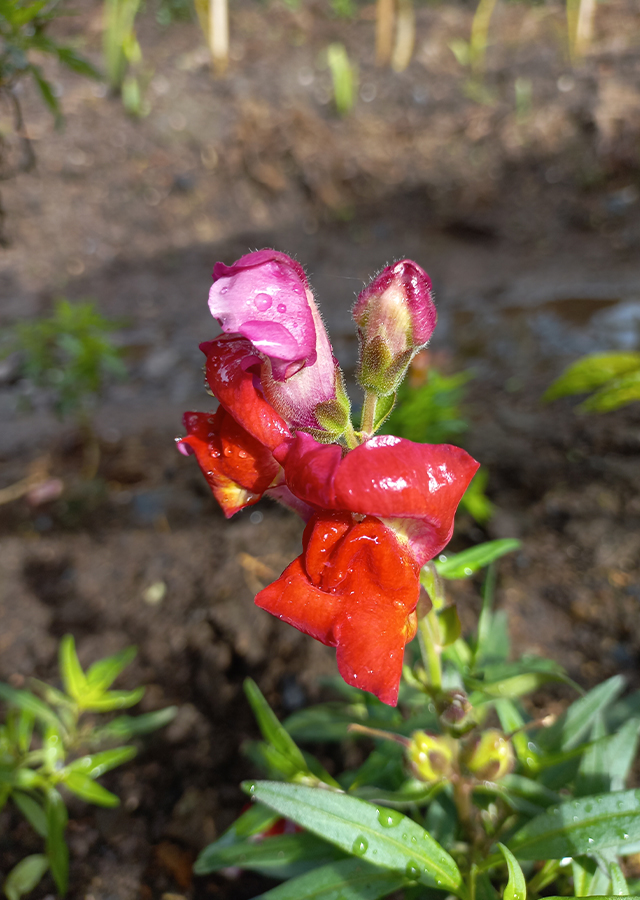Traditional Herbs from Antirrhinum majus
boils
- Take fresh leaves and flowers of the dragon's mouth plant, wash them clean.
- Crush them until they become a paste.
- Apply the paste to the boils.
- Do this repeatedly until they heal.
light_burns": ["Pick fresh flowers of the dragon's mouth plant, wash them thoroughly.
What is Antirrhinum majus Looks like??



Parts of Antirrhinum majus that could be used
- Leaves
- Flowers
- All Parts of the Plant
Antirrhinum majus Distribution
Antirrhinum magi is a flowering species whose distribution includes Africa (Algeria, Libya, Morocco and Tunisia), Asia (Palestine, Lebanon, Syria, Iraq and Turkey), Europe (Albania, Croatia, Greece, Italy, Malta, Serbia, France, Portugal ). It is now widely cultivated in temperate climates with a wide variety of colors and habits. This species is popularly grown as an ornamental plant and has long been used in the cut flower industry. In the medical world, Antirrhinum magus is widely studied for health purposes because this plant is known to contain various important compounds (anthocyanins and antirrhinosides). Where, anthocyanin is a substance that functions to inhibit the growth of tumor and cancer cells. Meanwhile, antirrhinoside is used in the pharmaceutical industry as a potential ingredient to make a number of biologically active compounds to treat various diseases. In Asia, the leaves and flowers have been used to relieve pain and reduce inflammation. Apart from that, in European folklore this species is also believed to be a flower that has supernatural powers. This species is thought to protect against evil spirits, magic and curses. Antirrhinum magi stems also produce fibers that can be used as textile materials. In the culinary world, Antirrhinum magi flowers are reported to have been used in salads and the seeds produce an oil lower than olive oil, which can be used as cooking oil.Agroecology of Antirrhinum majus
Antirrhinum magus can be found growing in disturbed areas, forests, bushes, hard rock outcrops, old walls, rocks, and dry places. This species is more suitable for planting in cold areas but is also suitable for planting in areas with moderate temperatures. Prefers well-drained, moist, loamy soil rich in organic matter and a sunny position or in full sun. This species is able to grow and is tolerant of clay soil, limestone soil, and also nutrient-poor soil. This species is also intolerant of freezing temperatures below zero and flooding.
Morphology of Antirrhinum majus
- Stems tall, erect, fleshy,
- Leaves regular and arranged in a spiral around the stem and twigs, opposite, lanceolate to oval-lanceolate, up to 7.6 cm long, leaf margins flat, dark green.", "Bisexual flowers, 10-20 flowers borne in terminal racemes. Zygomorphic, with two 'lips' closing, the corolla tube is three-lobed and has a variety of colors (white, yellow, orange, pink-purple, red old). Has five-lobed petals and four pubescent stamens.
- Fruit capsule, oval-shaped like a skull.
- There are many seeds in each fruit, small, black, oblong-ovoid (ovoid) .
Cultivation of Antirrhinum majus
- Generative (seed) and vegetative (cuttings) propagation.
- Seed seeding, carried out in early spring. Seeds can usually germinate in 10 - 21 days at a temperature of 18 \u00b0C.
Antirrhinum majus, more details :
Chemical Content of Antirrhinum majusAmino acids, anthocyanidins, flavonols, flavones (including apigenin 7,4′-diglucuronide, luteolin 7-glucuronide, chrysoeriol 7-glucuronide, kaempferol 3-glucoside, kaempferol 3,7-diglucoside), aurones (bracteatin 6-glucoside), flavanones, cinnamic acid, four tertiary alkaloids (one of which is 4-methyl-2,6-naphthyridine), four main iridoid compounds (antirrhinoside, antirrhide, 5-glucosyl-antirrhinoside, and linarioside), chalcones (chalcononaringenin 4′-glucoside and 3,4,2� �,4′,6′-pentahydroxychalcone 4′-glucoside), myrcene, (E)-beta-ocimene, and methyl benzoate.
Benefits of Antirrhinum majus
Treats scurvy, liver disorders and tumors, stimulant and as a poultice on tumors, relieves urinary tract infections, heals minor wounds and burns, detoxifies the blood, treats boils and abscesses, helps reduce fever, treats all types of inflammation and hemorrhoids, treats watery eyes , avoid skin infections and fight sunburn. Has activity as a diuretic, antimicrobial, anti-inflammatory, cytotoxic, antioxidant.
Simplisia of Antirrhinum majus
Another Facts for Antirrhinum majus :
Synonym of Antirrhinum majusOrontium majus (L.) Pers., Termontis racemosa Raf.
Habitus of Antirrhinum majus
Herb. Short-lived annual or perennial upright herb, its height ranges from 20 - 100 cm
Habitat of Antirrhinum majus
- Forest
- Rocky Area
- Land
No comments:
Post a Comment